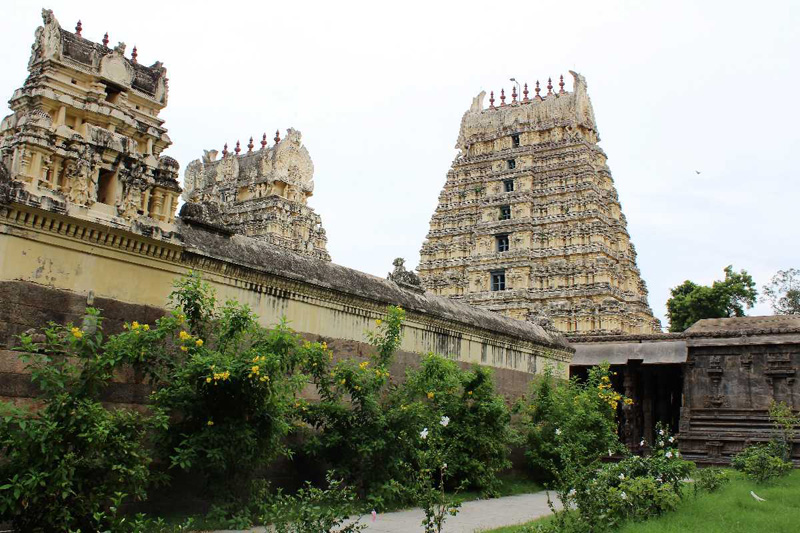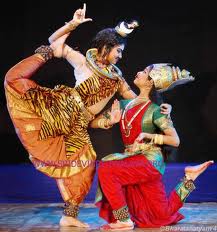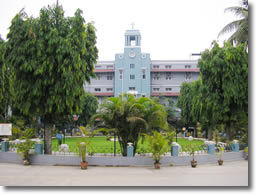Vellore, the Head-Quarters of Vellore District situated in 12' 35' N and 79' 9' E , has a very interesting History of its own. A strategically located town, it is well connected by Rail and bus routes to major towns of the neighboring states like A.P. Karnataka and Kerala. The History of the district assumes a great significance and relevance, as we unfold the glorious past.
It was under the sway of various dynasties and rulers, the prominent among them being the Pallavas, Cholas of Uraiyur, the Rashtrakutaa dynasty of Malkhed, Sambuvarayar, the rulers of Vijayanagarm, Mamathas, the Nawabs of the carnatic and the British. The Monuments found in the district give a vivid picture of the town through the ages. In the 18 th Century Vellore District was the scene of some of the decisive bettles fought in Ambur (1749) A.D Arcot (1751) A.D and Vandivasi (1760A.D) as a result of the long-drawn struggle between the English and the French for Supremacy.
One of the monuments of Vellore is the fort and its exact date of construction could not be established, in the absence of proper records. A very close examination of the stone inscriptions suggests that the fort in all probability might have been built during the rule of Chinna. Bommi Nayak (1526 to 1595A. D). The fort is one of the most perfect specimens of Military architecture in India.
The Jalakandeswarar Temple inside the fort is very fine example of Vijayanagar architecture. The Kalyanamandapam, on the left of the entrance, with intricate caring and delicacy of exaction, bears testimony to the engineering marble and advanced state of sculpture of the times.
Another land mark that has put Vellore on the center stage of Medical world is the Christian Medical College Hospital. Dr . IDA Scudder, the American lady, with a missionary zeal, started her Medical work in 1900 A.D. by setting up a very small Hospital, which in the last hundred years has grown into a premier Medical Institution of international repute.
The central prison in Vellore, set up in 1830 A.D. is another Historically important land mark as some eminent personalities and Freedom Fighters like Thiru. Rajaji, Thiru C.N. Annadurai, Thiru. K. Kamaraj, the former presidents of India Thiru. V.V.Giri, Thiru. R.Venkata Raman had served their prison terms here.
The other note worthy monuments are the Mausoleums located in Aruganthampoodi area on the Vellore-Arcot road, where the family members of Tippu Sultan were buried and the Muthu mandapam on the banks of river of palar, a memorial raised by the Tamil Nadu Government to honor Vikarama Raja Singha, the last Tamil King who ruled Kandy (Srilanka ) from 1798 to 1815 A.D. He was imprisoned in Vellore fort for 17 years.

THE ROLE OF VELLORE DISTRICT IN THE FREEDOM STRUGGLE
 Vellore District had always been on the fore-front in the struggle for the freedom. In fact the Sepoy Mutiny of 1806 A.D. that broke out inside the Vellore fort against the British authority is considered to be a prelude to the Great Revolt of 1857, which is often described by some historians as the first war of Independence.
Vellore District had always been on the fore-front in the struggle for the freedom. In fact the Sepoy Mutiny of 1806 A.D. that broke out inside the Vellore fort against the British authority is considered to be a prelude to the Great Revolt of 1857, which is often described by some historians as the first war of Independence.
The outstanding performance of this district in contributing to the Military service is Commendable, as more and more men have enlisted themselves to the Military service, to serve the nation with indomitable sprit and courage. The clock tower in the long Bazaar Vellore was built in 1920 A.D. a stone inscription in the building reads "Vellore-From this Village 277 men want to the Great war 1914-18, of them 14 gave up their lives". This is a recorded testimony the Velore and Military prowess of this area.
ECONOMIC, SOCIAL, CULTURAL CHANGES IN VELLORE IN 20TH CENTURY
 The economic condition of the district in the earlier stages was not very sound in the absence of the major industries. Thanks to the sustained efforts and Vigorous police of the Govt . Industries like Bharat Heavy Electricals Ltd Ranipet, Tamil Nadu Explosives Ltd., Katpadi. Have been set up. Besides there has been marked growth of small scale industries and Tanneries in the district.
The economic condition of the district in the earlier stages was not very sound in the absence of the major industries. Thanks to the sustained efforts and Vigorous police of the Govt . Industries like Bharat Heavy Electricals Ltd Ranipet, Tamil Nadu Explosives Ltd., Katpadi. Have been set up. Besides there has been marked growth of small scale industries and Tanneries in the district.
This industrial activity has not only generated employment opportunities, but also contributed. Uzhavar to economic growth the recently introduced Uzhavar Sandhai, for instance has benefited the rural poor giving much needed thrust to the economic. The innovative self help groups of woman are also playing a very useful role in building rural economy and helping rural women to be self reliant.
The social scenario also has changed keeping pace with the changing times. Increased social awareness and upward social growth mark the successful story of the district. The bonded labour, the child labour, etc. Are fast disappearing giving place to new social order. A striking feature of the social change is that the district achieved cent percent literacy owing to the effective implementation of the Arivoli, Movement.
The Samathuvapurams that are being set up, in various parts of the districtherald a new era, as social harmony and peaceful co-existence of different communities are the basic concept of this scheme. The Varumun Kappom Thittam by proving basic infrastructure to rural folk for a free medical examination is indeed a milestone in the social history of Tamil Nadu.
The cultural impact in the society is also very significant same of the traditional arts of the District like the Therukoothu, an art form folk theaters, Kokkalikottai, a famous traditional dance in the district are gradually vanishing. But it is also a matter of solace to note that some of the handicrafts for which the Vellore district are renowned, are still flourishing Mats making in Walajapet, silk weaving in Arni and the traditional art of pot making in Vellore and places around, are some of the handicrafts which are enable to successfully withstand challenges through ages. The poomalai scheme that has been introduced by the govt. will not only preserve the traditional handicrafts, but also promote their growth.
DEVELOPMENT OF COLLEGIATE EDUCATION IN THE DISTRICT
 The Vellore District is one of the leading districts of the state. Where the development of the education has been consistently good and commendable. The American Arcot mission, which was established in Vellore center in 1853, has the distribution of pioneering the cause of higher education by establishing The American Arcot mission College afflilated to the University of Madras as early as 1898. This later come to be known as Voorhees College.
The Vellore District is one of the leading districts of the state. Where the development of the education has been consistently good and commendable. The American Arcot mission, which was established in Vellore center in 1853, has the distribution of pioneering the cause of higher education by establishing The American Arcot mission College afflilated to the University of Madras as early as 1898. This later come to be known as Voorhees College.
The Sacred Heart College, Tirupattur the Auxilium College, (for women) at Katpadi are other Christian institutions dedicated themselves to the cause of education. The Govt .of Tamil Nadu with an ambitious scheme and ardent desire to promote higher education, setup series of Arts Colleges throughout the state. The Muthurangam Govt. Arts College, Vellore. Thirumagal mills Govt Arts college, Gudiyatham Arigar Anna Arts college for women, Walajah have been established in the rural end poor students.
The private participation in the growth of higher education in the District is also over whelming. The D.K.M. College for women Vellore is a fine Example.
Some Muslim Philanthropists and educationists, realising the need to wide open opportunities for the muslim youth to learn higher education, have established educational centers. The Islamiah college, Vaniayambadi, C. Abdul Hakeem college, Melvisharam, Mazhrul-uloom college, Ambur, the Muslim minority Institutions are also contributing their mite in promoting higher education in the District. The Arabic College in Vellore town is another important educational center for higher education.
The district is not Lagging behind in providing professional education. The Christian Medical College, Vellore. Which is of international repute, is offering even P.G. courses in some specialised branches. By starting an Engineering College, the Govt. also has fulfilled the aspiration of the student community of this district. In view of the financial constraints, in the Last few years, the Govt., has encourage self financing Institutions.
The Vellore engineering College, Vellore, which has many academic distinction to its credit, The Priyadershini engineering college, Vaniyampadi, have come into existence as a result. And there is also Govt. Teachers Training College, in Vellore offering both U.G. & P.G. courses. The phenomenal growth of these educational institution in the district only testify the growing demand and the keen interest evinced by the student community for higher and professional Education.
THE ROLE OF VELLORE DISTRICT IN THE DRAVIDIAN CIVILIZATION
 Vellore has a blend of heritage and culture reflecting the ancient Dravidian civilization. It was the seat of the Pallavas, Cholas, Nayak, Marathas, sssArcot Nawabs and Bijapur Sultan Kingdoms. Vellore was once the capital city of the Vijayanagar empire during 1606-1672. The fort in Vellore was described as the best and strongest fortress during the Carnatic War in the 17th Century. The monuments found in the district give a vivid picture of the evolution of the city through the ages.
Vellore has a blend of heritage and culture reflecting the ancient Dravidian civilization. It was the seat of the Pallavas, Cholas, Nayak, Marathas, sssArcot Nawabs and Bijapur Sultan Kingdoms. Vellore was once the capital city of the Vijayanagar empire during 1606-1672. The fort in Vellore was described as the best and strongest fortress during the Carnatic War in the 17th Century. The monuments found in the district give a vivid picture of the evolution of the city through the ages.
In the centuries before India's independence there were many changes in kingdoms of the south and their capitals. The north and south regions of Arcot came into the political map in 1810 at the time of the last Mughal Emperor. Later in 1908, the two districts, namely North and South Arcot, came into existence. Chittoor (now in Andhra Pradesh) was the first capital of the North Arcot district. From then on it was the principal military base of the British. In 1911, Vellore became the head quarters of North Arcot Dt., comprising Vellore and Thiruvannamalai.
ETYMOLOGY
The name is said to have originated from Vel (spear-வேல்) which is the main weapon of the Hindu deity Murugan or 'Velayudayaan' (one who bears the spear). The word then literally means-The place of Murugan. The name Vellore is derived from the Tamil words Vel (spear-வேல்) + uur ( ஊர்-city ) meaning City of Spears. Ancient history shows that Vellore was a battle field where the warriors used to fight was left with abandoned weapons like spears. The name Vellore is also said to have been derived from some form of precious stone which had a similar sounding name. There is megalithic proto-historical evidence in and around Vellore of such a semi-precious stone industry being prevalent in ancient times.
VELLORE SEPOY REVOLT
The Vellore Revolt of 1806 was the earliest recorded uprising against British rule in India and is widely considered as the actual "First War of Independence" though it is also considered to be the "Meerut Sepoy Mutiny". Vellore District had always been at the forefront in the struggle for freedom. The Sepoy Revolt of 1806 AD that broke out inside the Vellore fort against the British authority is considered to be a prelude to the Great Revolt of 1857. A pillar commemorating the revolt has been installed in front of the fort and a monument in memory of the fighters is to be built at another location in the city.




